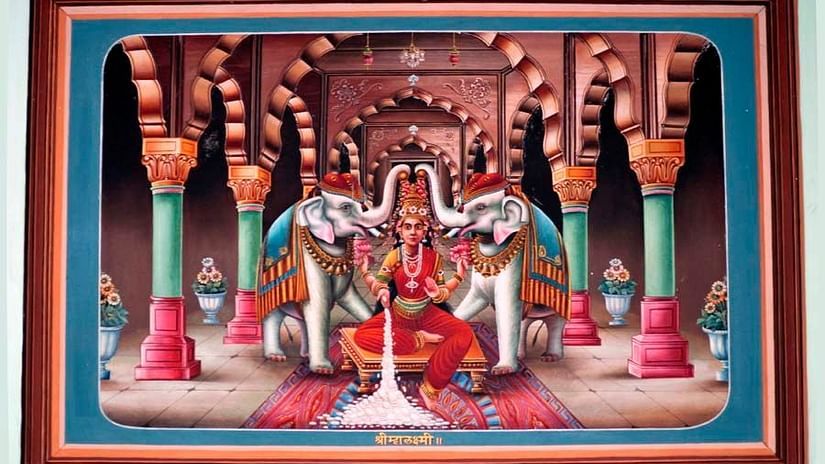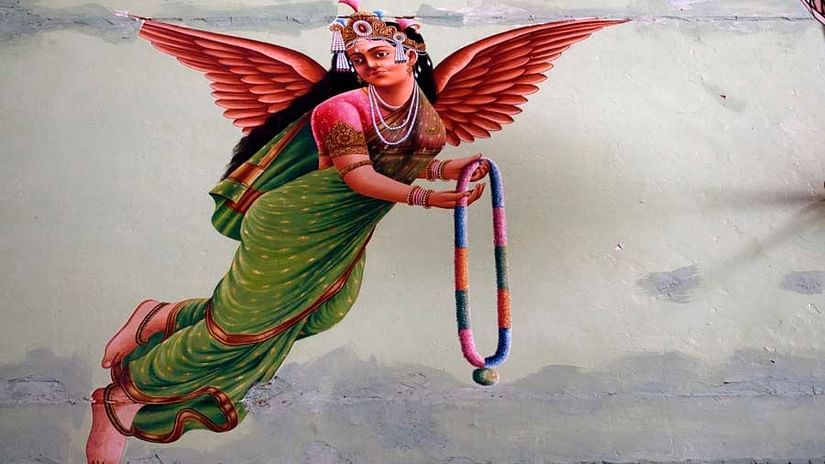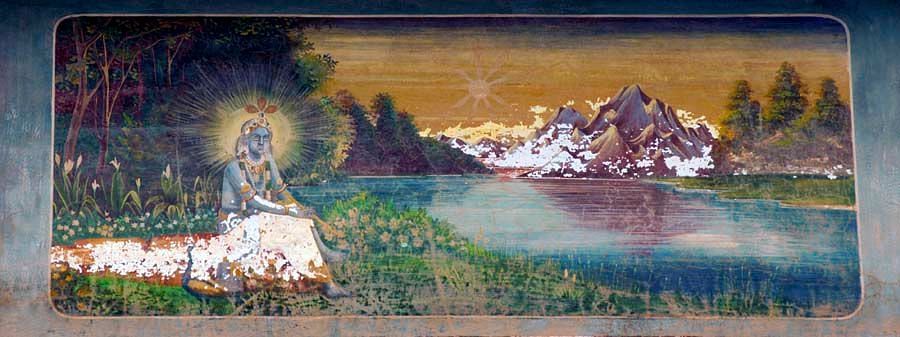Within the Region in India known as Rajasthan lies Shekhavati, and in Shekhavati lie the empty forts of the Rajputs – the once powerful warrior caste – and the huge, painted mansions of merchant families who have long since departed to the cities, leaving their beautiful frescoed houses to the ravages of time.
The frescoes from that region, is a testimony to Shekhavati, to the past prosperity of a society which once proudly displayed its vitality by elaborately decorating courtyards, walls and ceilings with a pictorial record of its customs, beliefs, mythology and monies and floral designs cover practically every inch of the houses of the Rajput warriors and mercantile classes, revealing far more clearly than words the history of the people of Shekhavati from Mughal times, through the eighteenth and nineteenth centuries, until the influence of the British, with their customs and new technology, began to dominate.
In the beginning, the desert offered only its blank palette. There is no record of a distinct school of painting in Shekhavati before the frescoes. History took up this colourless page and, through a series of interactions, made Shekhavati blossom with frescoes. But then, after a short span of some two hundred years, the art was lost and history passed by – a silent, unparticipating spectator.


If you look at the history of Shekhawati Frescoes, it was massively influenced by the Jaipuri and Mughal schools of painting, which in turn had been inspired by Persian art. A study of the art styles and forms of the desert states and the royal Mughal court in Delhi and Agra reveals a series of exchanges. The initiation of the Mughal studio in Delhi probably took place in the reign of Humayun, after he returned from the Safavid court in Persia, bringing with him Persian master painters, illuminators and bookbinders. Under his successor, Akbar, Hindu painters were recruited from all over India, mingling with the many traditions in the royal ateliers. As the strength and influence of the Mughal court grew, more leading craftsmen brought Indian architectural traditions into Mughal building practices, and in particular, Rajput styles into Mughal painting.
Akbar’s marriage in 1562 to Harka Bai of Jaipur brought Rajput blood into the dynasty itself, to forge an even stronger link. Akbar’s Fatehpur Sikri, a far cry from the Muslim concepts of order and symmetry, is a fine example of the coming together of the two styles. Flouting the Muslim tradition which precludes the depiction of life (as outlined in the Hadith, a compilation of the sayings of the Prophet). Jodha Bai’s private apartments at Fatehpur Sikri were apparently painted with frescoes containing figures, of which little remains now. Also, Akbar’s hunting lodge at Bairat, in Alwar District, is ornately painted with human figures, birds, animals and even Hindu deities and mythological representations. It was Akbar who understood better than anyone else that if the interaction were to work it would have to be generously reciprocal. If he were to harness the skills of his Hindu subjects (which formed the majority), he could not forbid the spontaneous outflow of their imagery and reference symbols. (Only a liberal, enlightened Muslim monarch could have commissioned the Ramayana and Mahabharata in Persian.) In his far-sighted recognition of this fact lay the magnetism which drew anyone of significance to his court.
Shah Jahan, the next great Mughal builder, continued the Rajasthani bias: both his mother and his grandmother had been Rajput princesses. When Aurangzeb reversed the established religious tolerance of the Mughals, his move had far-reaching effects in the field of art. It can be argued that this was not, in fact, what Aurangzeb had intended. The letter that he dictated from his deathbed is full of repentance. He had contrived to become sovereign by murder, and by having his brothers arrested. To alleviate these crimes perhaps he felt compelled to take refuge in orthodox religion, threatening Hindu conversions by the sword. Labour left the fields, the looms of industry were abandoned and the doors of the royal ateliers were bolted. The artists surged out, to colour the palettes of the neighbouring courts. The traditions which had once contributed to Akbar’s ateliers now returned enriched with Mughal-Persian influences.
Later, Sawai Jai Singh’s newly founded city of Jaipur welcomed the few artists, craftsmen, poets, writers, musicians and lawgivers who had remained in the hope of seeing better days at Delhi but were now fleeing the weakened Mughal court of Mohammad Shah. Although Shekhavati had been enveloped once more into the folds of Jaipur, it was nevertheless away from the luxuries and patronage of the court. Years of comparative peace, prosperity and security in Shekhavati gave birth to its own patrons – the traders who built elaborately painted havelis with the enormous wealth they had accumulated along the trade routes and at the ports. The frescoes sprang up through patronage peculiar to itself: much money had been generated by these desert people, and for sentimental reasons, they wished to spend it on their hometowns. This naturally also brought them social prestige.


While most other schools of painting in Rajasthan have restricted themselves to miniatures on paper, ivory and wood (with the exception of some frescoes on palaces and temples), the Shekhatvati paintings are on quite another scale. Here the miniature paintings grow from the diminutive, almost as if they had flown into the streets and stretched themselves to life size. Royal elephants bedecked in regalia, splendid horses and camels parade with superbly attired persons in a pageantry that record an era now left behind.
The wall paintings of Shekhavati are not seasonal or ritualistic, though for the layman they seem as decorative as the paintings of Madhubani in Bihar, Warli in Maharashtra, Chhota Udaipur in Gujarat, and others. On the popular, impermanent wall paintings. Pupul Jayakar comments:
The adornment of the walls of the home by use of earth plaster, mirrors, seeds reliefs in clay, the painting of the walls with icons of the Puranic gods and with ornamental forms of birds, serpents, flowers and geometric diagrams exist in areas where the clay walls of village huts provide a canvas for such decoration… the walls of the hut, the street, the shop and themarketplace becomethe picture gallery, the canvas on which the records of the race, the exploits of godand heroare maintained. But the paintings are transitory and anonymous. They appear on the walls, fade, are whitewashed over and reappear with the cyclic movement of the seasons and therelated rituals.
In contrast to these seasonal paintings for rituals and ceremonies, the frescoes of Shekhavati are as permanent as the walls they adorn. The earliest ones in Shekhavati are found in the forts which are the oldest standing structures in the area. Among these, the forts of Sikar, Nawalgarh, Dunlod, Mandawa Malsisar, Khetri, Surajgarh and Shahpura still have early examples of frescoes. Despite the fact that the Rajputs spent more time in battle than in patronising the arts, one of the first and most outstanding frescoes in Shekhavati, dated 1750, is found on a Rajput cenotaph – that of Shardul Singh at Parasrampura. Other cenotaphs with painted chhatris appear in most towns, but those built to commemorate the Marwari merchants of Bissau and Ramgarh are prominent. Another kind of chhatri not in its mortuary form appears as a little-canopied kiosk that provided shelter by a well. Of these, the two finest examples of painted ceilings are to be found in Chirawa while Malsisar has a different example of a closed chhatri painted on the outside.
The typical Shekhavati Wells announce the presence of water with four tall minarets, often painted in bold black lines and sometimes including a simple portrait of Hanuman. A long slope, equivalent to the depth of the well in the driest season, enables the villagers to draw water by pulling ropes or by using camels and bullocks on the gradients. Since the water level is normally low the interiors of the wells are also occasionally painted. Perhaps the best examples of these are the Harlalka and Aggarwal wells of Mandawa. Sometimes, faded frescoes remain on the johras built to gather rainwater. The paintings on the Ojha johra in Baggar still hold out against the elements.
Frescoes are also commonly found in temples that exist in almost all the towns of Shekhavati. Of these, early examples appear in Khetri, Ramgarh, Malsisar, Gyangyasar and Chirwa. Those at Dundlod have now been covered with whitewash.
Not every haveli is painted: in particular, many of the later ones in Mandrela, Churi Ajitgarh, Chirana and Kanjara stand lime-white and graphic against the changing skies of Shekhavati.
Perhaps the single most outstanding example of a painted haveli is the Soné Chandi ke haveli (painted in 1846), which belongs to the Podars of Mahansar. Its foremost room, a ‘T’ shaped hall which is reputed to have been the showroom of a jeweller, gives it its name, which means ‘the house of gold and silver’. Gilded strappings and mirrored ceilings create a bewildering opulence around finely painted frescoes, which are mainly of mythological subjects. Exquisite floral friezes border the lower half of the wall, and an intricately carved central wooden beam supports the ceiling. An equally fine fresco, possibly by the same hand, is painted on the ceiling of a dome in the old fort of Nawalgarh which depicts an aerial view of the city of Jaipur.
